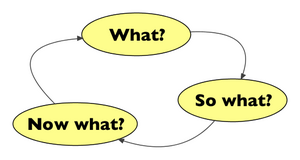Table of Contents
Adaptive Action Cycle
This feedback technique is designed for iterative processes which can benefit from periodic cycles of evaluation and adaptation. At the core of the technique are three seemingly simple questions: what, so what and now what. When asking 'what' we look at facts, data and the status quo of a situation. 'So what' probes the meaning of the gathered data, the implications of the work, uncovers the patterns, challenges and possibilities, and invites honest reflection. 'Now what' invites us to pause, to temporarily slow down to assess the impact of the process, and if necessary rethink and adapt things that haven't worked as well as expected. It encourages us to base our 'next steps' on lessons learned in the previous phase. The benefit of this technique in its flexibility, adaptability, and the process of continuous enquiry it entails. Furthermore, it focuses on constructive feedback and iterative learning-by-doing. The adaptive action cycle was developed by Royce Holladay of the Human Systems Dynamics Institute.
At FoAM we used this technique very informally in short debrief sessions, as well as in formal evaluation workshops. In both cases it provided an unobtrusive framework to structure conversations and to give participants a feeling that feedback sessions are not only backward-looking, but actually encourage forward movement into the next phases of a process or project.
Process
The adaptive action cycle is a simple structured conversation in three rounds. If a co-present meeting is not possible, this technique can work as a written questionnaire as well.
- Step 1: Frame the session as a debrief that will allow the group to look back and look forward on a process they recently completed.
- Step 2 (optional): In a small group you can simply guide the participants through the conversation. In a larger group it is beneficial to break out into smaller groups that either stay together for three rounds, or rotate in a world cafe style. In the case of breakouts you can ask participants to volunteer as 'table moderators' who will report at the end of the session. You can provide worksheets with the written questions and some space to write the reports.
- Step 3: The first round of conversation focuses on What? What did you do? How did you do it? How do you feel about it? What do you not know yet?
- Step 4: The second round begins with inquiring So what? So what does all this mean? So what worked? So what was challenging? So what are the implications of our work? So what opportunities do we see emerging?
- Step 5: The last round looks towards the future and asks Now what? Now, what needs to change? Now what different approaches could we take? Now what would success look like? Now who will do what? If needed at the end of this round you can distribute 'pledge sheets' on which people can write what they are willing to commit to for the next phase of the process.
- Step 6: Summarise conversations. If you are working in one group you or another participant summarises the key points that were brought up during the three rounds. If you worked with the breakout groups, each table moderator briefly reports the key points, while you cluster and summarise the whole conversation and make a brief report at the end. Ask the participants if you forgot or misinterpreted anything and allow a few minutes for additions. Make sure that the next steps are clearly defined and that people know how to proceed.
